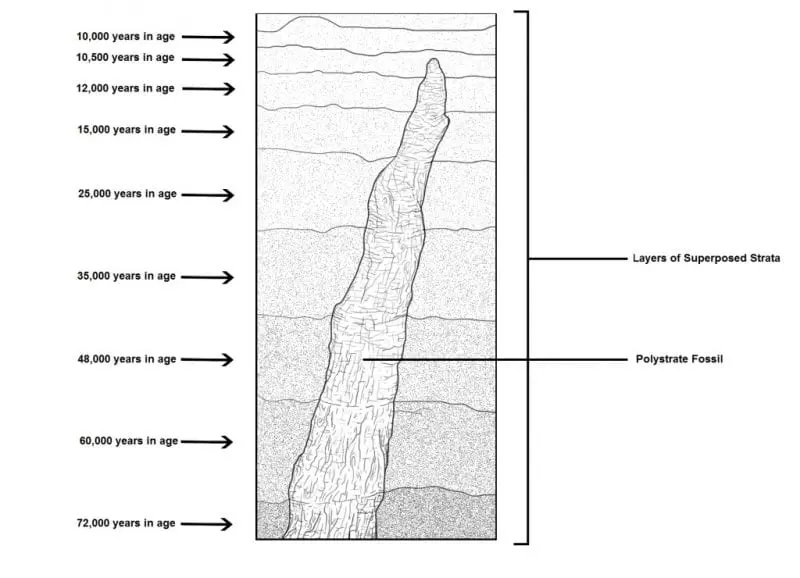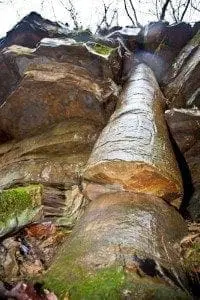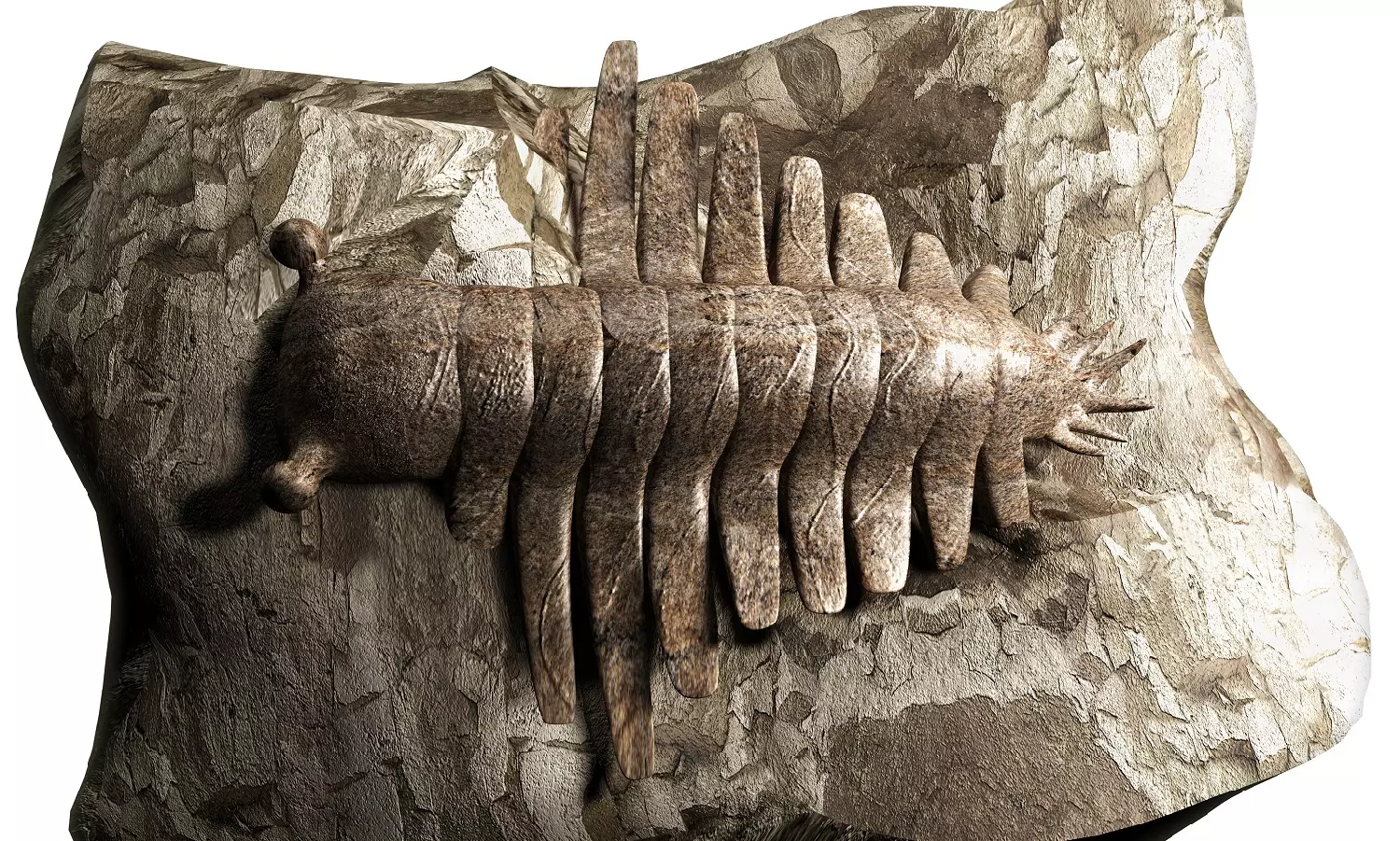[Originally published as Problems, Part 2]
What are we to make of fossils that seemingly contradict the standard model, existing in layers they are not supposed to? This is a frequent occurrence¹, and as with much else, it is typically explained away in kind. For some, such as those consisting of ancient fossils occurring in younger sediment, the mainstream attests that this is simply a case of disturbance, whereby the ancient fossils have been reworked into the younger strata, incorporated over time within those fresh sediments.
One must question though what degree of luck it would require for the rock surrounding an ancient fossil to be largely eroded away, only to have a new wave of deposition occur just in time to preserve the fossil therein…
Conversely, there are also instances of “young” fossils being preserved within ancient strata. Ever at the ready, mainstreamist researchers attribute such instances to downwash, whereby the younger organism becomes trapped within a cave or sinkhole, only to gradually be preserved as “old” sedimentary material gradually fills the area. The result from our standpoint is of a “geologically recent” organism fossilized within ancient material, and it, if not properly handled by the authorities, could prove to be a hurdle for the accepted geological model of an ancient planet.
Thus we see again that the science is not only questionable behind such explanations, but also that the motives to counter such finds in many cases is obvious.
Concerning such anomalies as these, one researcher has compiled approximately 200 published instances in the technical literature.² While some of these cases are likely mistaken, the fact remains that those which remain pose a serious threat to the mainstream paradigm, not only in terms of dating given strata, but also effectively casting doubt on the use of index fossils as a whole. So much of a threat in fact, that it is likely that many such instance may go unreported, thus changing the landscape of the data to more effectively maintain the current model of geological deep-time.
Multi-layer Fossils
There exists another form of fossil which should make us again question the gradualism of mainstream geology. These fossils are referred to as “polystrate,” and what makes them unique is their position with the rocks, whereby these fossils bisect many individual strata. Most polystrate fossils consist of tree trunks, preserved in such a way as to stand vertically, or nearly so, through millennia of sedimentary rock. How are we to assume that a tree, or other such matter, remained perfectly in place, without suffering decomposition or other effects, while the sedimentary layers in which it was preserved underwent the process of lithification?

As one researcher, in observation of certain English polystrate fossils, put it, “If one estimates the total thickness of the British Coal Measures as about 1000 m, laid down in about 10 million years, then, assuming a constant rate of sedimentation, it would have taken 100000 years to bury a tree 10 m high, which is ridiculous…”³
 There are of course those among the mainstream which counter the implications of such fossils with claims that they represent only instances of tree roots which had invaded ancient soils (known as paleosols) only later to become fossilized among those ancient sediments, or that such are formed due to their proximity to environments conducive to rapid sediment accumulation, such as within wet or even volcanic regions, or simply that these polystrate fossils are a result of downwash, as described above.
There are of course those among the mainstream which counter the implications of such fossils with claims that they represent only instances of tree roots which had invaded ancient soils (known as paleosols) only later to become fossilized among those ancient sediments, or that such are formed due to their proximity to environments conducive to rapid sediment accumulation, such as within wet or even volcanic regions, or simply that these polystrate fossils are a result of downwash, as described above.
Still others suggest they were formed during powerful deposition events, such as mighty floods and volcanic eruptions. Perhaps, some attest, they are indicative of an unprecedented flood event. Whatever they ultimately may represent, they are worth noting here.
Out of Place Fossils
Beyond instances of polystrate fossils, there exist a great many other fossils which seemingly stand in opposition of the mainstream deep-time paradigm, as offered through geological insights. For example, there are many cases in which, instead of singular fossils displaced between various younger or older strata, there are whole layers that exhibit fossils that stand in opposition to the mainstream model, whereby the concept of superposition is cast out of the window.
In other instances, we find examples of fossils which have been conclusively identified as belonging within strata that are very different from that originally accepted by the mainstream. Consider the case of the unique index fossil anomalocaris (see image at the top). For years it was regarded as being a specific identifier for Cambrian strata, yet recently it was identified in so-called Ordovician rocks, pushing its existence to a geologically younger age by some fifty million years! 4
Even more condemning is a recent discovery involving the pollen of flowering plants. For decades, it has been a standard within mainstream research that flowering plants, known as angiosperms, had not evolved until the Cretaceous period. As such, most classic reconstructions of that age featured dramatic confrontations of tyrannosaurus and triceratops set against a backdrop of bland ferns and conifers, with not a flower in sight.
In recent years however this imagery has seen somewhat of a change, as the remains of perfect rhododendrons, poppies, walnut, and other flowering forms have been discovered from that time. What’s more is that new evidence has completely altered that paradigm again, as the pollen of fully developed angiosperms has been discovered in Triassic strata, dating according to the mainstream to some 240 million years old. In effect, this find demonstrated that the accepted timeline was off by at least 100 million years!5
– This was an excerpt from “Remnants of Eden: Evolution, Deep-Time, & the Antediluvian World.” Get your copy here today. God bless! –
References:
- “Woodmorappe, J., “Studies in Flood Geology 2nd Edition Institute for Creation Research, El Cajon, pp 87–92p. 126, 1999
- Ibid
- Ager, D.V., “The New Catastrophism,” Cambridge University Press, 1993,pg 49
- Thomas, B., “Out of Place Marine Fossil Disrupts Evolutionary Index,” Creation Science Update. Posted on icr.org June 14, 2011, accessed March 21, 2014
- Hochuli, P. A. & S. Feist-Burkhardt,“Angiosperm-like Pollen and Afropollis from the Middle Triassic (Anisian) of the Germanic Basin (Northern Switzerland),” 2013, Frontiers in Plant Science. 4: 344








This wikipedia article seems to point to a considerable body of work pushing back by proposing testable hypotheses that explain this process. https://en.wikipedia.org/wiki/Polystrate_fossil
I’m not seeing these testable hypotheses. What I do see is them talking about rapid sedimentation but with proposed gaps of time before and after. In fact, they see exactly the same kinds of sudden inundation that flood geologists do; they just refuse to allow the cataclysms to be as big.
Creationists themselves point to the micro laboratories of places such as Mount St. Helens as examples of the much wider results of the global flood. Having a small-scale example does nothing to preclude a larger-scale version.